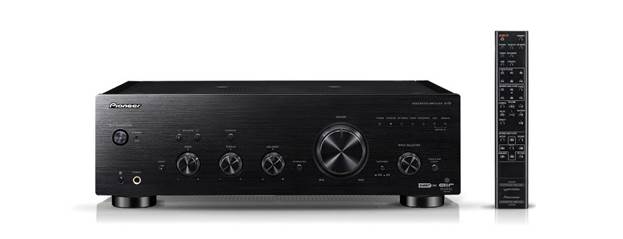The heavyweight of the group, this integrated sets out to do
everything and, by and large, does so very well
This is the flagship of Pioneer’s current stereo output and
is the biggest and heaviest amplifier here. Not content with the most
metalwork, the A-70 also has the most comprehensive spec. As well as the four
RCA line inputs, it has a pair of digital inputs (one of which is an
asynchronous USB) and a phonon stage that supports moving coil cartridges as
well as moving magnet. The only feature not available is a pair of XLR
connections – although as none of the Pioneer source equipment in the same
range is so partnered, this is not too surprising. Internally, the A-70 is the
only amplifier here to make use of a Class D output stage, claimed to produce
65W of output into 8ohms that is available over two switchable speaker inputs.

Pioneer A-70
The result is a physically imposing amp, but one that is
attractively and cleanly styled. Much of the extra weight is a result of the
chassis design, which features a completely separate chassis plate to combat
vibration. Only the slight lack of resistance in the volume control and the
slightly lightweight secondary controls spoil the effect, but nothing feels
flimsy. The remote is bespoke and attractive to look at, but does suffer from
having many buttons that are all the same size arranged fairly close together,
which means that it isn’t the easiest to navigate unless you are looking
directly at it.
Sound quality
The A-70 doesn’t sound as big and powerful as it looks, but
still manages a performance that is extremely likeable, with a well-defined and
believable soundstage. It is a smooth performer that doesn’t sacrifice detail
in doing so. The Muse vocals are well represented with plenty of texture and
space to them and the reproduction of the Neil Cowley Trio piano is potentially
the best in the group with a genuinely impressive size and weight to the
instrument along with a total lack of harshness or aggression with higher
notes.

The A-70 doesn’t
sound as big and powerful as it looks
This civility continues with the Scratch Massive piece and
the Pioneer softens the rawness that can be present without losing the fine
detail. With both this and Aloe Blacc, however, its tendency towards smoothness
and control results in a piece that lacks some of the life and excitement that
the Creek brings to the party and while the performance is extremely
technically competent, it doesn’t have quite the same emotional engagement that
the best in the test manages to have with the same material. The A-70 also
never tips over into becoming matter of fact or showing up the shortcomings in recordings,
but this seems to come at the expense of a little excitement. This being said,
the scale that the Pioneer amp can generate is very good indeed and the bass
response is both deep and possessed of the same impressive detail as the rest
of the frequency spectrum.
Whether this refinement and smoothness is the right thing
for you is going to come down to the rest of your system and your musical
preferences. The Pioneer has an impressive ability to keep even the roughest of
recorded material sounding listenable, but equally when some recordings ask for
a bit more excitement, it can be a little reluctant to truly deliver the goods.
Many people will like how the A-70 goes about its business, though, and the
very impressive feature set and substantial build are likely to help it win a
lot of people over.

The A-70 also
never tips over into becoming matter of fact or showing up the shortcomings in
recordings, but this seems to come at the expense of a little excitement.
One test
The only Class D amplifier in our test consumes 25W when
idle but just 170W at its rated 2x65W/8ohm power output. While this is an
efficiency of 76%, the optimum ~85% is only achieved at maximum output which,
in this case, is rather closer to 2x80W/8ohm and 2x135W/4ohm. Unlike some other
Class D amps, the A-70 offers a higher output under dynamic conditions – 100W,
190W and 320W into 8, 4 and 2ohm (<1% THD).
Distortion increases from 0.0007-0.02% from 1W to 65W
through bass and midrange but, because of the inductive output filter required
by almost all Class D amps, it’s much higher at high (20 kHz) frequencies. The
response of this Class D amp is also influenced by speaker loading but is
‘tuned’ to yield a slight treble lift of +0.5dB/20kHz and +1.3dB/35kHz into
8ohm but offer a gently rolled-off treble (–1.2dB/20kHz) into lower 4ohm loads.
Our verdict
·
Sound quality: 4.5/5
·
Value for money: 5/5
·
Build quality: 4.5/5
·
Features: 5/5
·
Like: Extensive features; controlled, smooth and detailed sound
·
Distributor: Can lack a little excitement
·
We say: A very capable amplifier that offers a lot of
functionality and a controlled sound
·
Overall: 4.5/5
|
Details
·
Product: Pioneer A-70
·
Origin: Japan/Malaysia
·
Type: Integrated amplifier
·
Weight: 17.1kg
·
Dimensions (W x H x D) : 435 x 141 x 361mm
·
Features: Quoted power output: 65W RMS per channel into 8ohms;
·
Available finishes: black/silver
·
Line inputs: 4 RCA inputs; Digital inputs; USB/coaxial
·
Distributor: Pioneer GB
|